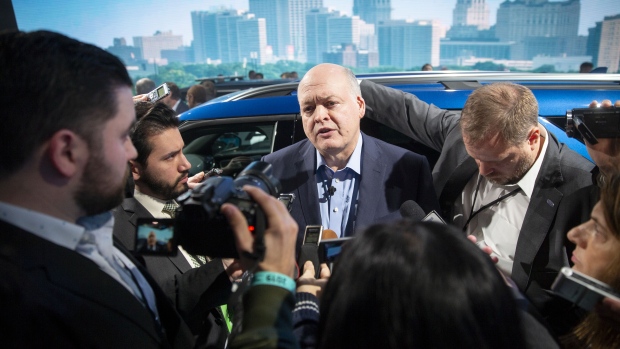Jan 23, 2019
Ford falls into the red as deficits drag down Q4
, Bloomberg News

Ford Motor Co. (F.N) descended into the red in the final three months of 2018, dragged down by deeper deficits overseas and a loss on its pension fund.
The automaker reported a net loss of US$116 million for the fourth quarter, missing analysts’ average estimate for income of US$1.27 billion. This is just the second quarterly loss Ford has posted on a GAAP basis since early 2009, according to data compiled by Bloomberg.
Chief Executive Officer Jim Hackett has been trying to overhaul the automaker by killing off slow-selling sedans, boosting spending on sport utility vehicles and trucks, and making salaried staff cuts worldwide. Last week, he announced an alliance with Volkswagen AG to jointly develop commercial vans and trucks and said the two companies will explore working together on electric and self-driving cars. But analysts have criticized the company for not providing more details on its turnaround plans and failing to give guidance on its 2019 outlook, other than saying it has the potential to be better than last year.
“It’s not a year that we were happy with, and the fourth quarter kind of continued in that vein,” Bob Shanks, Ford’s chief financial officer, told reporters at the company’s headquarters in Dearborn, Michigan. “We do understand the parts of the business that need to be improved, in some cases dramatically. We know what we need to do, and we are acting to do so. We are taking steps to redesign the business, particularly outside North America.”
Ford shares swung between gains and losses in late trading. The shares have rebounded somewhat this year after plunging 39 per cent in 2018.Shanks described about US$3.4 billion worth of headwinds Ford faced last year. This tally included:
Roughly US$1 billion related to commodity costs About US$770 million each linked to tariffs and Takata air-bag recalls Around US$760 million in unfavorable foreign-exchange swings
The CFO reiterated that the U.K.’s efforts to leave the European Union have major implications for the company, whose namesake brand is the top-seller in Britain. If the country ends up making a so-called hard exit from the trade bloc in March, there will be a “material impact” on Ford, Shanks told reporters.
“We clearly have already started to work on the eventuality of there being a hard Brexit,” Shanks said. “We’re certainly hoping that does not happen, but we can’t wait until the 29th of March to see what that might be. So we’re actually incurring costs and doing things now to prepare for that.”
Ford reported an US$877 million loss on its pension and retirement-benefit plans for the quarter. Excluding that and other items, the company posted an adjusted profit of 30 cents a share, in line with analysts’ estimates and preliminary results released last week. That’s down from 39 cents a share a year earlier.
While fourth-quarter earnings before interest and taxes were higher in North America, as Ford sold a richer mix of higher-priced trucks and SUVs, the company posted bigger losses than a year ago in Asia, Europe and South America.




